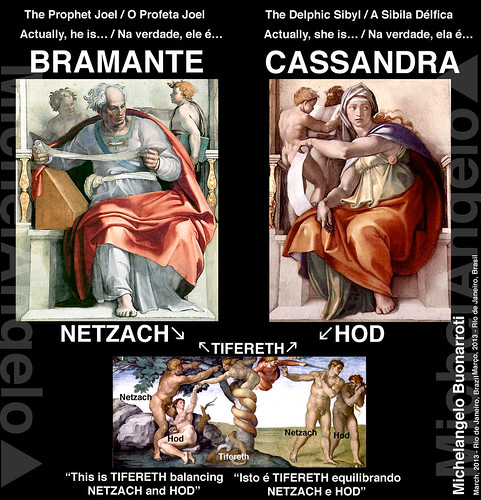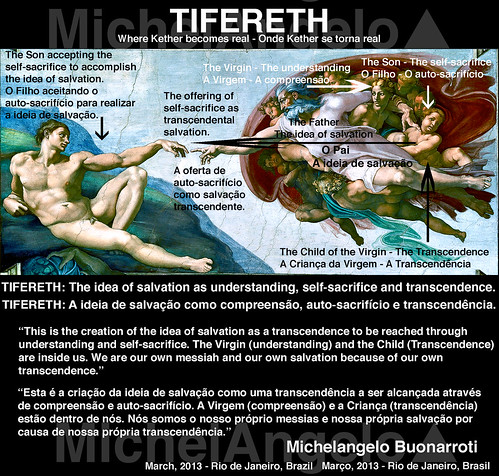English
30 years ago… PUC-Rio University… The Henrique's dream
The first semester of 1983 was THE most weird, supernatural, freak moments of my entire life. There was a mix of strangeness and absurd situations that I would never faced again in my entire life. I think that part of the emotional impact can be related to my young age (22 year-old) and to the feeling that there was something terrible inside myself to be understood. Summarizing it in a very few paragraphs.
In my final stage at the university, I went in a partnership with a strange guy named Henrique. He already knew that I was Michelangelo reincarnation since a insight that he had during a class in 1980. He was aware of my spiritual identity one year before the very appearance of my classic drawing. And at that time, he had a dream with me and wrote it on a piece of paper just for the record of dreams he usually did.
The moment that I revealed myself to him, showing my drawings and telling him about my remembrance of Vittoria Colonna (march,1983), it was what triggered the whole situation that I'm still immerse today (and where I will remain for the rest of my life).
The next week, Henrique showed up in class with a small piece of paper in his hand. It was the paper where the dream from two years ago was written on. The dream was a precise description of the terrible situation we were going to deal with during our partnership. But at the end of the dream, the ants (the only who could save us) made two question for me to answer: 1# When will be the next rains? 2# When the Giant Anteater will go south? The ants needed to know how to avoid the anthill destruction caused by rain and prevent the attacks from the Giant Anteater.
At the most stressful moment of our project for the universtity, Henrique was deeply convinced that spiritual forces was the reason of our failure and he put the blame on me for the opposition of those spiritual forces. For him, my bad attempts on answering the two questions from the ants and find the meaning of the dream were revealing that my attitude about the spiritual matters at that time was wrong. Because of that, Henrique asked me:
– Didn't you have any dream with Monica?
(Monica: the girl who was a lookalike of Vittoria Colonna and whose proximity helped me on remembering passages of my life as Michelangelo.)
And… yes! I finally recalled that on the final days of february, 1983, I had a dream with Monica. It was just one. My dream in a few words: after putting together pieces of an old newspaper to understand a message for me, I went in the direction of Monica just to say to her that she has a spiritual name, but because of my emotion it was impossible for me to tell her the name. So I decided to spell the name, writing on her notebook. First, I simply write "M-o-n-i-c-a" on Monica's notebook, but one distraught female voice called my attention:
– Michelangelo, you have to write her name!!! You know her name!!! What's is her name, Michelangelo???
I stop for a second and say to myself:
– Yes! I know her name!
With my hand shaking because of the emotion, I started writing letter by letter: V-I-T-T-O-R-I-A C-O-L-O-N-N-A.
After hearing this, Henrique went crazy. Screaming like a lunatic, he stated:
– Don't you see??? The old piece of paper with the written dream IS like an old piece of newspaper!!! And you have been "putting together pieces of paper" since I revealed to you my dream from 2 years ago!!! Your dream is showing YOU trying to understand my dream!!! You have do to something about this girl called Monica!!!
After a silent moment, dazed with the situation, I admitted to myself that the pieces of paper that I saw in my dream were the paper where Henrique's dream was written on.
The passage above describes in a very short way what happened in march, april and may of 1983. At the end of may, I went in the direction of Monica, in the university campus, trying to understand what the spiritual forces were trying to show me.
The symbolic meaning of the questions from the ants in Henrique's dream:
1# When will be the next rains?
This question is an ironic demand and a warning. It's predicting that one day I will tell my story and reveal myself to everyone the same way I did to Henrique, in march of 1983. It's clear that "something" (God, the supernatural, whatever) knew that I was decided to hide myself forever. This expected error would destroy my entire life (this is implicit in the ironic demand).
2# When the Giant Anteater will go south?
This question reveals my fate because of my wrong decision of not revealing to others that I am Michelangelo reincarnation indeed. "Going south" means finding the reincarnation of Vittoria Colonna, or in others words it means "getting married". The Giant Anteater it's my own description in the future, as someone who survives of small contacts with women, "eating" small females, the ants (the word "ant" in portuguese is feminine). This second question is a condemnation of never finding a "Vittoria Colonna" because of my decision of never expressing myself as Michelangelo himself.
The full movie: http://michelangelo00.blogspot.com.br/
Português:
30 anos atrás ... Universidade PUC-Rio… O Sonho do Henrique.
O primeiro semestre de 1983 foi o mais estranho, sobrenatural e bizarro de toda a minha vida. Havia uma mistura de estranheza e situações absurdas que nunca mais encontrei em toda a minha vida. Acho que parte do impacto emocional pode ser atribuído à minha pouca idade (22 anos) e à sensação de que havia algo muito grave dentro de mim para ser compreendido. Resumindo parte daquela loucura em alguns poucos parágrafos.
Na minha fase final na universidade, formei grupo com um cara bem estranho chamado Henrique. Ele já sabia que eu era a reencarnação de Michelangelo por causa de um insight que ele teve durante uma aula, em 1980. Ele estava consciente da minha identidade espiritual um ano antes do aparecimento do meu desenho clássico. E foi nessa época que ele teve um sonho comigo e o anotou em um pedaço de papel, como parte dos registros de sonhos que sempre fazia.
O momento em que me revelei a ele, mostrando meus desenhos e falando sobre a minha lembrança da Vittoria Colonna (março de 1983), foi o que desencadeou toda a situação em que estou imerso hoje (e onde certamente vou ficar para o resto da minha vida).
Na semana seguinte, ele apareceu com um pedaço de papel na mão onde o tal sonho comigo de dois anos atrás estava escrito. O sonho era uma descrição precisa da difícil situação que enfrentaríamos durante a nossa parceria em projeto da faculdade. Mas no final do sonho, as formigas (as únicas que poderiam nos salvar) faziam duas perguntas para eu responder: 1) Quando serão as próximas chuvas? 2) Quando que o Formiga (um imenso tamanduá-bandeira) vai para o sul? As formigas precisavam saber as respostas para salvar o formigueiro das chuvas e conseguir escapar dos ataques do Formiga.
No momento mais estressante do nosso trabalho no projeto, Henrique se convenceu de que forças espirituais eram a razão do nosso fracasso e colocou a culpa em mim pela oposição dessas forças espirituais. Para ele, as minhas tentativas erradas em responder as duas perguntas das formigas e encontrar o significado do sonho indicavam que eu estava com uma atitude errada em relação à minha situação espiritual da época. Por isso, o Henrique me perguntou:
- Você não teve nenhum sonho com Mônica?
(A Mônica era uma sósia da Vittoria Colonna, cuja proximidade provocou as lembranças da minha vida como Michelangelo.)
E finalmente lembrei que nos últimos dias de fevereiro de 1983, eu havia tido um sonho com a Monica. Foi apenas um. O meu sonho em poucas palavras: depois de juntar pedaços de beirada de jornal velho para compreender uma mensagem para mim, eu vou na direção da Mônica só para dizer a ela o seu nome espiritual. Mas por causa da minha emoção era impossível falar o tal nome. Então, decidi soletrar o nome, escrevendo-o no caderno dela. Primeiro, eu simplesmente escrevo "Mônica" no caderno de Monica, mas uma voz feminina muito aflita chama a minha atenção:
- Michelangelo, você tem que escrever o nome dela!!! Você sabe o nome dela!!! Qual é o nome dela, Michelangelo???
Eu paro por um segundo e digo a mim mesmo:
- Sim! Eu sei o nome dela!
Com a mão tremendo por causa da emoção, começo a escrever letra por letra: V-I-T-T-O-R-I-A C-O-L-O-N-N-A.
Depois de escutar o meu relato, o Henrique foi à loucura. Falando alto como um louco, ele declara:
- Você não vê??? O velho pedaço de papel com o sonho escrito é como um pedaço de jornal velho!!! O seu sonho descreve você mesmo tentando entender o meu sonho! Você tem que fazer algo a respeito desta garota chamada Mônica!
Depois de um momento em silêncio, atordoado com a situação, admiti que os pedaços de papel que vi em meu sonho eram o papel onde o sonho do Henrique estava escrito.
A passagem acima, descrita de maneira muito resumida, aconteceu em março, abril e maio de 1983. No final de maio, fui na direção da Mônica, no campus da universidade PUC-Rio (Pilotis), tentando entender o que as forças espirituais queriam me revelar.
O significado simbólico das perguntas das formigas no sonho Henrique:
1) Quando serão as próximas chuvas?
Esta pergunta é uma exigência em tom irônico e um alerta. Ela já prevê que um dia eu irei contar a minha história e me expressar a todos da mesma forma que fiz com o Henrique, em março de 1983. "Algo" (Deus, o sobrenatural, o que for) já sabia que eu estava decidido a manter segredo. Este esperado erro meu iria destruir a minha vida inteira (esta ideia está implícita na pergunta).
2) Quando que o Formiga (um imenso tamanduá-bandeira) vai para o sul?
Esta pergunta revela o meu destino por causa da decisão errada de não revelar aos outros que sou a reencarnação de Michelangelo. "Ir para o sul" significa encontrar a reencarnação da Vittoria Colonna, ou, em outras palavras, significa casar. A imagem do imenso tamanduá-bandeira era a minha própria descrição na vida adulta que se iniciava, como alguém que sobrevive de pequenos contatos com as mulheres, "comendo" as "mulheres pequenas", ou seja, as "formigas". Esta segunda pergunta é uma condenação a nunca encontrar uma "Vittoria Colonna" por causa da minha decisão de nunca me expressar como sendo o próprio Michelangelo.
O filme completo: http://euricopoggi.blogspot.com.br/












